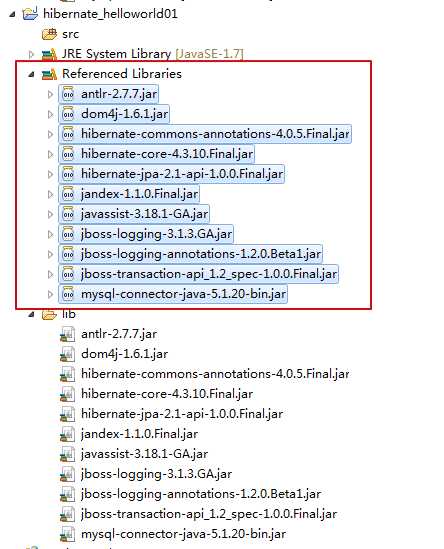标签:config false out 图片 private host ring col property
这篇文章,会一步一步的演示hibernate的使用。
目录结构如下:
1.新建java项目


2.增加一个lib文件夹,并把 hibernate必须的jar包 和 数据库驱动包 一起复制进去


然后把hibernate必需的jar包和mysql的驱动包复制进入

3.把lib下的jar包 ,进行build path

注意:是选中lib下的jar包进行build,而不是选中lib文件夹
效果如下:

4.准备数据库表

5.在src下编写 hibernate.cfg.xml 文件
添加过程如下:


hibernate.cfg.xml 文件内容如下:
<!DOCTYPE hibernate-configuration PUBLIC "-//Hibernate/Hibernate Configuration DTD 3.0//EN" "http://www.hibernate.org/dtd/hibernate-configuration-3.0.dtd"> <hibernate-configuration> <session-factory> <!-- 数据库连接信息 --> <property name="connection.driver_class">com.mysql.jdbc.Driver</property> <!-- 默认 localhost:3306 --> <property name="connection.url">jdbc:mysql:///test</property> <property name="connection.username">root</property> <property name="connection.password">root</property> <!-- 通用配置 --> <!-- 方言:hibernate要支持多种数据库,根据不同数据库生成对应的sql语句 告诉hibernate使用的什么数据库,以便生成对应数据库的sql --> <property name="hibernate.dialect">org.hibernate.dialect.MySQLDialect</property> <!-- 打印sql语句 --> <property name="show_sql">true</property> <!-- 映射信息 --> <mapping resource="cn/vincent/pojo/User.hbm.xml"/> </session-factory> </hibernate-configuration>
6.编写User类(或者叫pojo类),是放在新加的cn.vincent.pojo包下
结构如下:

/** * pojo类 需要实现序列化接口 * 必须提供无参的构造方法, * 推荐将hashCode,equals重写 * @author siggy * */ public class User implements Serializable{ private int id; private String name; private int age; public int getId() { return id; } public void setId(int id) { this.id = id; } public String getName() { return name; } public void setName(String name) { this.name = name; } public int getAge() { return age; } public void setAge(int age) { this.age = age; } @Override public int hashCode() { final int prime = 31; int result = 1; result = prime * result + age; result = prime * result + id; result = prime * result + ((name == null) ? 0 : name.hashCode()); return result; } @Override public boolean equals(Object obj) { if (this == obj) return true; if (obj == null) return false; if (getClass() != obj.getClass()) return false; User other = (User) obj; if (age != other.age) return false; if (id != other.id) return false; if (name == null) { if (other.name != null) return false; } else if (!name.equals(other.name)) return false; return true; } }
对于上述代码,可以在写好private属性后,如下所示,进行生成get/set方法,和hashcode即equal方法

7.编写pojo类所对应的的映射文件:User.hbm.xml
结构如下:

内容如下:
<?xml version="1.0" encoding="UTF-8"?> <!DOCTYPE hibernate-mapping PUBLIC "-//Hibernate/Hibernate Mapping DTD 3.0//EN" "http://www.hibernate.org/dtd/hibernate-mapping-3.0.dtd"> <hibernate-mapping> <class name="cn.vincent.pojo.User" table="t_user"> <id name="id" column="id" type="int"> <generator class="native"></generator> </id> <property name="name" column="name" type="java.lang.String"/> <property name="age" column="age" type="int"/> </class> </hibernate-mapping>
8.编写代码实现查询单个对象
结构如下:

内容如下:
public class HibernateDemo { public static void main(String[] args){ //1、读取hibernate配置文件 Configuration cfg = new Configuration().configure(); //2、创建服务注册对象 ServiceRegistry registry = new StandardServiceRegistryBuilder() .applySettings(cfg.getProperties()) .build(); //3、生成SessionFactory对象 SessionFactory factory = cfg.buildSessionFactory(registry); //4、生成Session对象 Session session = factory.openSession(); //5、查询 User user = (User)session.get(User.class, 2); System.out.println(user.getId()+"----"+user.getName()+"----"+user.getAge()); //6、关闭session session.close(); //在应用程序中sessionFactory不用关闭 factory.close(); } }
github地址:https://github.com/Vincent-yuan/hibernate
标签:config false out 图片 private host ring col property
原文地址:https://www.cnblogs.com/Vincent-yuan/p/11197107.html